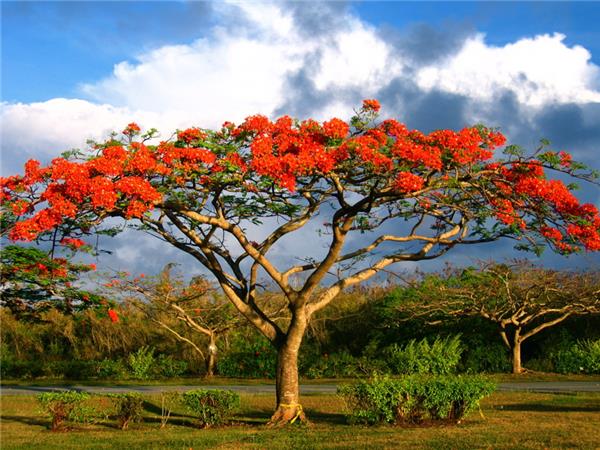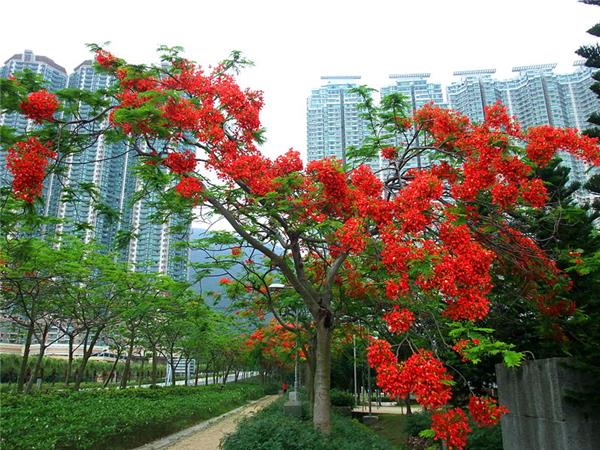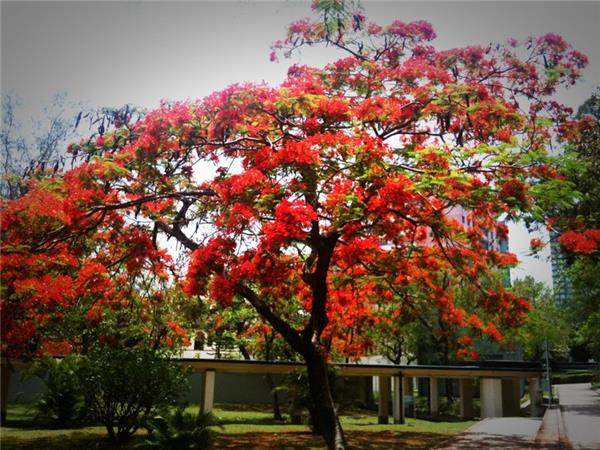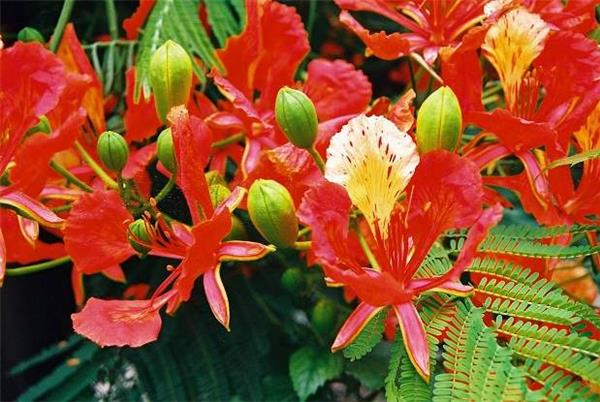Phoenix wood, an amazingly beautiful fiery red tree species
The ornamental effect of Phoenix wood is very good. When its flowering time comes, the red and eye-catching Phoenix flowers all over the tree bloom, just as if there is a Phoenix on the tree. People will be attracted at first sight and have the magic of love at first sight. Let's take a look at how to plant this kind of tree.

1. Cultivation and management techniques of Phoenix wood
Soil conditions: choose loose, fertile, well-drained loam or sandy loam, such soil is suitable for seedling seed germination, growth and development, and strong seedlings, less diseases and insect pests. Never choose clay, waterlogged land, saline-alkali land, vegetable garden or places with thinner soil as nursery land.
Seed treatment: the seed shell of Phoenix wood seed is hard and thick, it is not easy to absorb water, and its germination is slow and irregular. Seed treatment and germination must be carried out before sowing. The conventional method is as follows: one month before sowing, soak the seeds in water and change the water every 3-5 days to make the seeds fully absorb water, soften the seed coat, and sow the seed coat before sowing.
Correct sowing: strip sowing is generally used to propagate. The sowing time is generally from late February to mid-April. The distance between strips is 20~25cm, the depth of each ditch is 3 ~ 4 cm, the length of each ditch is equal to the width of the bed (1 m), 10 ~ 15 seeds are evenly sown in each ditch, the thickness of soil after sowing is 2.5~3cm, covered with pine needles or straw, and drenched with water after sowing to keep the soil moist and prevent the growth of weeds.

II. Control of root rot of Phoenix wood
Symptoms: Phoenix wood has become an important urban landscape greening tree species because of its beautiful shape and bright colors. The disease invades the roots of Phoenix trees, causing the roots of trees to rot and die. At the initial stage of the disease, the tree grew slowly, and the crown was sparse and yellowed, until the disease period, the growth of the standing tree almost stopped, and the shedding leaves made the crown more sparse. White hyphae or reddish-brown fruiting bodies are common in the interland or exposed roots of the diseased plants. The surface of the diseased root from fine root to coarse root is covered with mycelium, showing spider web, fan or felt shape, and its tissue is rotten, and the wood tissue also has mycelium growth. At the end of the disease, the standing wood withered and died, and many fruiting bodies grew in the roots of the earth. The disease causes serious harm to the street trees of Phoenix trees and Acacia trees in the middle and south, especially those over 10 years old.
Etiology: the pathogen of this disease is Ganoderma lucidum, which is transmitted by spores of Ganoderma lucidum through water or wind, as well as through the roots of trees in the soil.
Prevention and control methods:
1. Cut down diseased plants, dig roots and fruiting bodies, burn them centrally, and disinfect the soil.
2, trench blocking, spraying 75% pentachloronitrobenzene wettable powder 750 times dilution, in order to prevent the spread of the disease.

Third, how to distinguish between Phoenix wood and albizzia
1. Phoenix wood bipinnately compound leaves alternate, long 2060cm pinnae 1520 pairs, opposite pinnae long 510cm 2040 pairs of leaflets; leaflets dense, small, long elliptic, entire tip obtusely round, base oblique, long 48mm wide 2.53mm, thin papery, smooth and thin, turquoise, leaf veins only obvious midrib, both surfaces sericeous.
two。 Albizia is a deciduous tree with two even pinnately compound leaves, 412 pairs of pinnae, 10 ~ 30 pairs of leaflets, oblong to linear leaflets, extremely oblique on both sides, long 612mm and wide 14mm, day opening and night closing.
3. The biggest difference between Phoenix wood and albizzia mono in terms of leaves is that Phoenix wood has 1520 pairs of pinnae, while Albizia has only 412 pairs of pinnae.

If you have friends in the courtyard at home, choosing Phoenix wood to plant in the courtyard will definitely give you a lot of harvest, because it will use its magnificent beauty and fiery red to make your courtyard deeply attract the attention of others and be appreciated and envied by others.
- Prev

What are the culture methods and matters needing attention of golden diamond?
What are the culture methods and matters needing attention of golden diamond?
- Next

Maintenance and management technology of pomelo how to control diseases and insect pests
Maintenance and management technology of pomelo how to control diseases and insect pests
Related
- Wuhan Hospital Iron Tree Blooming Result Was Instantly Frightened by the Gardener Master
- Which variety of camellia is the most fragrant and best? Which one do you like best?
- What is the small blue coat, the breeding methods and matters needing attention of the succulent plant
- Dormancy time and maintenance management of succulent plants during dormancy
- Minas succulent how to raise, Minas succulent plant pictures
- What are the varieties of winter succulent plants
- How to raise succulent plants in twelve rolls? let's take a look at some experience of breeding twelve rolls.
- Attention should be paid to water control for succulent plants during dormant period (winter and summer)
- Watering experience of twelve rolls of succulent plants
- Techniques for fertilizing succulent plants. An article will let you know how to fertilize succulent plants.

